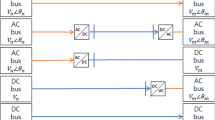Abstract
This paper demonstrates the convergence of the integrated AC-DC power-flow algorithm as affected by the selection of different base values for the DC quantities and adoption of different control strategies for the DC link. For power-flow modeling of integrated AC-DC systems, the base values of the various DC quantities can be defined in several ways, giving rise to different sets of per-unit system equations. It is observed that different per-unit system models affect the convergence of the power-flow algorithm differently. In a similar manner, the control strategy adopted for the DC link also affects the powerflow convergence. The sequential method is used to solve the DC variables in the Newton Raphson (NR) power flow model, where AC and DC systems are solved separately and are coupled by injecting an equivalent amount of real and reactive power at the terminal AC buses. Now, for a majority of the possible control strategies, the equivalent real and reactive power injections at the concerned buses can be computed a-priori and are independent of the NR iterative loop. However, for a few of the control strategies, the equivalent reactive power injections cannot be computed a-priori and need to be computed in every NR iteration. This affects the performance of the iterative process. Two different per-unit system models and six typical control strategies are taken into consideration. This is validated by numerous case studies conducted on the IEEE 118-bus and 300-bus test systems.
Similar content being viewed by others
References
Arrillaga J, Watson N R. Computer Modelling of Electrical Power Systems. 2nd ed. Sinapore: John Wiley & Sons Ltd, 2003
Kundur P. Power System Stability and Control. New York: Tata McGraw-Hill Publishing Co. Ltd., 2007
Wang X F, Song Y H, Irving M. Modern Power Systems Analysis. New York: Springer, 2008
Acha E, Kazemtabrizi B, Castro L M. A new VSC-HVDC model for power flows using the Newton-Raphson method. IEEE Transactions on Power Systems, 2013, 28(3): 2602–2612
Angeles-Camacho C, Tortelli O L, Acha E, Fuerte-Esquivel C R. Inclusion of a high voltage DC-voltage source converter model in a Newton-Raphson power flow algorithm. IEE Proceedings-Generation, Transmission and Distribution, 2003, 150(6): 691–696
Zhang X P. Multiterminal voltage-sourced converter-based HVDC models for power flow analysis. IEEE Transactions on Power Systems, 2004, 19(4): 1877–1884
Braunagel D A, Kraft L A, Whysong J L. Inclusion of DC converter and transmission equations directly in a Newton power flow. IEEE Transactions on Power Apparatus and Systems, 1976, PAS-95(1): 76–88
Arritlaga J, Bodger P. AC-DC load flows with realistic representation of the converter plant. Proceedings of the Institution of Electrical Engineers, 1978, 125(1): 41–46
El-marsafawy M M, Mathur R M. A new, fast technique for load flow solution of integrated multi terminal DC/AC systems. IEEE Transactions on Power Apparatus and Systems, 1980, PAS-99(1): 246–255
Arritlaga J, Harker B J, Turner K S. Clarifying an ambiguity in recent AC-DC load flow formulations. IEE Proceedings C Generation, Transmission and Distribution, 1980, 127(5): 324–325
Smed T, Andersson G, Sheble G B, Grigsby L L. A new approach to AC/DC power flow. IEEE Transactions on Power Systems, 1991, 6 (3): 1238–1244
Reeve J, Fahny G, Stott B. Versatile load flow method for multi terminal HVDC systems. IEEE Transactions on Power Apparatus and Systems, 1977, PAS-96(3): 925–933
Fudeh H, Ong C M. A simple and efficient AC-DC load flow method for multiterminal DC systems. IEEE Transactions on Power Apparatus and Systems, 1981, PAS-100(11): 4389–4396
El-Hawary M E, Ibrahim S T. A new approach to AC-DC load flow analysis. Electric Power Research, 1995, 33(3): 193–200
Beerten J, Cole S, Belmans R. Generalized steady-state VSC MTDC model for sequential AC/DC power flow algorithms. IEEE Transactions on Power Systems, 2012, 27(2): 821–829
UW Electrical Engineering. Power systems test case archive. 2014-10-02, http://www.ee.washington.edu/research/pstca/
Author information
Authors and Affiliations
Corresponding author
Rights and permissions
About this article
Cite this article
Khan, S., Bhowmick, S. Impact of selection of DC base values and DC link control strategies on sequential AC-DC power-flow convergence. Front. Energy 9, 399–412 (2015). https://doi.org/10.1007/s11708-015-0374-6
Received:
Accepted:
Published:
Issue Date:
DOI: https://doi.org/10.1007/s11708-015-0374-6




